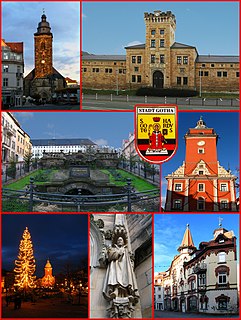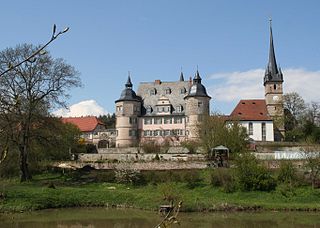Related Research Articles

Saxe-Coburg and Gotha, or Saxe-Coburg-Gotha, was an Ernestine, Thuringian duchy ruled by a branch of the House of Wettin, consisting of territories in the present-day states of Thuringia and Bavaria in Germany. It lasted from 1826 to 1918. In November 1918, Charles Edward, Duke of Saxe-Coburg and Gotha, was forced to abdicate. In 1920, the northern part of the duchy was merged with six other Thuringian free states to form the Free State of Thuringia: Saxe-Weimar-Eisenach, Saxe-Altenburg and Saxe-Meiningen, Schwarzburg-Rudolstadt and Schwarzburg-Sondershausen, as well as the People's State of Reuss. The southern part of the duchy, as southernmost of the Thuringian states, was the only one which, after a referendum, became part of the Free State of Bavaria.
Coburg is a Landkreis (district) in Bavaria, Germany. It is bounded by the districts of Kronach, Lichtenfels, Bamberg and Haßberge, and by the state of Thuringia. The district surrounds, but does not include the city of Coburg.

Charles Edward, Duke of Saxe-Coburg and Gotha was the last sovereign duke of Saxe-Coburg and Gotha from 30 July 1900 until 1918. A male-line grandson of Queen Victoria and Prince Albert, he was also until 1919 a Prince of the United Kingdom and from birth held the British titles of Duke of Albany, Earl of Clarence and Baron Arklow.

The House of Wettin is a dynasty of German counts, dukes, prince-electors and kings that once ruled territories in the present-day German states of Saxony, Saxony-Anhalt and Thuringia. The dynasty is one of the oldest in Europe, and its origins can be traced back to the town of Wettin, Saxony-Anhalt. The Wettins gradually rose to power within the Holy Roman Empire. Members of the family became the rulers of several medieval states, starting with the Saxon Eastern March in 1030. Other states they gained were Meissen in 1089, Thuringia in 1263, and Saxony in 1423. These areas cover large parts of Central Germany as a cultural area of Germany.

Gotha is the fifth-largest city in Thuringia, Germany, 20 kilometres west of Erfurt and 25 km east of Eisenach with a population of 44,000. The city is the capital of the district of Gotha and was also a residence of the Ernestine Wettins from 1640 until the end of monarchy in Germany in 1918. The House of Saxe-Coburg and Gotha originating here spawned many European rulers, including the royal houses of the United Kingdom, Belgium, Portugal and Bulgaria.

Coburg is a town located on the Itz river in the Upper Franconia region of Bavaria, Germany. Long part of one of the Thuringian states of the Wettin line, it joined Bavaria by popular vote only in 1920. Until the revolution of 1918, it was one of the capitals of the Duchy of Saxe-Coburg and Gotha and the Duchy of Saxe-Coburg-Saalfeld. Through successful dynastic policies, the ruling princely family married into several of the royal families of Europe, most notably in the person of Prince Albert, who married Queen Victoria in 1840. As a result of these close links with the royal houses of Europe in the late 19th and early 20th centuries, Coburg was frequently visited by the crowned heads of Europe and their families.

Princess Sibylla of Saxe-Coburg and Gotha was a member of the Swedish royal family and the mother of the current King of Sweden, Carl XVI Gustaf.

The House of Saxe-Coburg and Gotha is a German dynasty. It takes its name from its oldest domain, the Ernestine duchy of Saxe-Coburg and Gotha, but its members later sat on the thrones of the United Kingdom, Belgium, Portugal, Bulgaria, and Mexico.

Tambach-Dietharz is a town in the district of Gotha, in Thuringia, Germany. It is situated in the Thuringian Forest, 19 km south of Gotha.

Frederick I, Duke of Saxe-Gotha-Altenburg, was a duke of Saxe-Gotha-Altenburg. He was the fourth but eldest surviving son of Ernst I, Duke of Saxe-Coburg-Altenburg and Elisabeth Sophie of Saxe-Altenburg.

Ahorn is a municipality in the district of Coburg in Bavaria in Germany.

The Gotha G.III was a twin-engine biplane heavy bomber used by the Luftstreitkräfte during World War I. It succeeded the G.II in production and differed primarily in powerplant and in armament details. The G.II's unreliable V-8 Mercedes D.IV was replaced by the new inline six-cylinder 190 kW (250 hp) Mercedes D.IVa engine. The G.III also had a strengthened fuselage with an extra 7.92 mm (0.312 in) machine gun firing through a ventral gun tunnel in the belly to protect the underside of the tail.

Hubertus, Hereditary Prince of Saxe-Coburg and Gotha was a German courier pilot and a member of the House of Saxe-Coburg-Gotha, which reigned over the eponymous duchy in the German Empire. Born a prince of Great Britain and Ireland as the great-grandson of Queen Victoria, Hubertus lost this title during the First World War. He became Hereditary Prince as heir apparent to the headship of his house in 1932, and he never married. Hubertus joined the Nazi Party upon the outbreak of the Second World War despite his opposition to Adolf Hitler and Nazism. He served in the German Army on the Eastern Front until he was killed in action. He is the maternal uncle of King Carl XVI Gustaf of Sweden.

Princess Charlotte of Saxe-Meiningen was a member of the House of Saxe-Meiningen and a Princess of Saxe-Meiningen by birth and a member of the House of Saxe-Gotha-Altenburg and Duchess consort of Saxe-Gotha-Altenburg through her marriage to Ernest II, Duke of Saxe-Gotha-Altenburg.

The Veste Coburg is one of the most well-preserved medieval fortresses of Germany. It is situated on a hill above the town of Coburg, in the Upper Franconia region of Bavaria.
Justus Perthes Publishers was established in 1785 in Gotha, Germany. Justus Perthes was primarily a publisher of geographic atlases and wall maps. He published "Petermanns Geographische Mitteilungen" and also the Almanach de Gotha. In 2016 the publisher was discontinued.

The Free State of Coburg emerged from the Duchy of Saxe-Coburg and Gotha at the end of the First World War. It existed from November 1918 until its union with the Free State of Bavaria on 1 July 1920.
"Aus der Tiefen rufe ich, Herr, zu dir" is a German hymn with a text by Georg Christoph Schwämmlein. The opening lines of the hymn stay close to those of Psalm 130, while most stanzas of the hymn are written from a Christian perspective. It was first published, with its own hymn tune, in the Nürnberg hymnal of 1676. Gottfried Vopelius published it with a new hymn tune in the 1682 Neu Leipziger Gesangbuch, p. 936. From 1699 to 1738 the hymn was published with four more new melodies.
The 1920 Gotha state election was held on 30 May 1920 to elect the 19 members of the Landtag of Gotha.
The 1921 Gotha state election was held on 6 March 1921 to elect the 15 members of the Landtag of Gotha.
References
- 1 2 Gonschior, Andreas. "Der Freistaat Gotha Landtagswahl 1919". Wahlen in der Weimarer Republik. Archived from the original on 2003-07-25. Retrieved 18 May 2021.